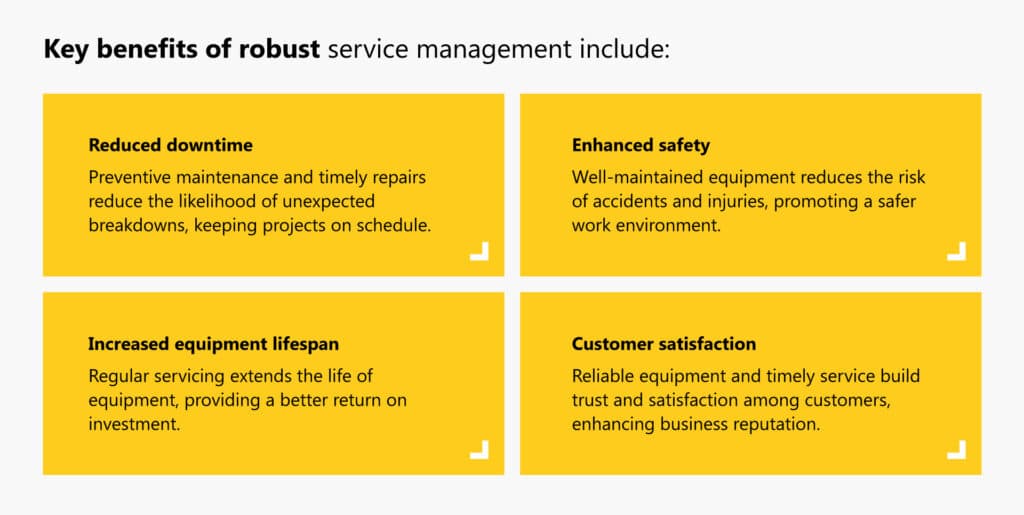Imagine a busy construction site with cranes lifting heavy loads, excavators shaping the terrain, and massive loaders moving materials. In this environment, equipment are the true workhorse. But what happens when these equipment need maintenance?
Welcome to the world of managing service for equipment businesses!
Service management for heavy equipment is crucial for any successful operation. It’s all about keeping these machines running efficiently, minimizing downtime, and maximizing performance.
Whether you’re a seasoned industry professional or just getting started, this guide will explore the essential aspects of equipment service management, including its importance, common challenges, and best practices to overcome them.
The importance of service management
Equipment, such as construction machinery, agricultural implements, and industrial tools, plays a vital role in various industries. These equipment are often critical to the success of projects and operations. Therefore, maintaining their optimal performance through effective service management is essential.

Best practices for service management

1.Implement preventive maintenance
- Schedule regular maintenance checks and services based on equipment usage and manufacturer recommendations.
- Use data from equipment sensors and telematics to predict and prevent potential issues before they lead to significant downtime.
2. Utilize advanced technologies
- Invest in service management software that integrates with the needs of your business.
- Leverage IoT (Internet of Things) devices to monitor equipment health in real-time, providing insights into performance and potential issues.
3. Train and empower technicians
- Ensure that your service technicians are well-trained and knowledgeable about the latest equipment and technologies.
- Provide them with mobile tools and access to technical documentation to enhance their efficiency and effectiveness in the field.
4. Maintain a comprehensive service history
- Keep detailed records of all maintenance and repair activities for each piece of equipment.
- Use this data to track trends, identify recurring issues, and make informed decisions about equipment management and replacement.
5. Focus on parts management
- Maintain an organized inventory of spare parts to ensure that necessary components are readily available for repairs.
- Implement a parts management system to track inventory levels, order parts as needed, and avoid delays in service due to part shortages.
6. Enhance customer communication
- Keep customers informed about the status of their equipment, scheduled maintenance, and any potential issues.
- Use customer portals and mobile apps to provide real-time updates and facilitate easy communication between customers and service teams.
Challenges in service management
While there are best practices that can streamline service management, equipment businesses also face several challenges that can complicate these efforts.

1.Scheduling complexities
Coordinating maintenance schedules and service appointments for a large fleet of equipment can be challenging. Ensuring minimal disruption to operations while providing timely service requires sophisticated scheduling tools and strategies.
2. Field service management
Managing field service operations, including dispatching technicians to remote locations, ensuring they have the right tools and parts, and monitoring their progress, is a complex task that requires robust management systems.
3. Parts availability
Ensuring the availability of spare parts when needed is critical. Delays in obtaining parts can lead to extended downtime and frustrated customers. Effective inventory management and supplier relationships are essential to address this challenge.
4. Workflow bottlenecks
Inefficiencies in service workflows can cause delays and reduce productivity. Identifying and addressing bottlenecks in the service process is crucial to maintaining smooth operations.
5. Quality control
Ensuring the quality of repairs and maintenance is essential to prevent recurring issues and maintain equipment reliability. Implementing rigorous quality control measures and regular audits can help maintain high standards.
6. Customer engagement
Keeping customers informed and engaged throughout the service process is vital for building trust and satisfaction. Clear communication and timely updates can help manage customer expectations and improve their overall experience.
7. Diagnostic accuracy and integration
Accurately diagnosing issues with complex equipment and integrating diagnostic tools with service management systems can be challenging. Ensuring technicians have access to accurate diagnostic data and integrating this information into service workflows can improve repair accuracy and efficiency.
8. Technician skills tracking
Keeping track of the skills and training of service technicians is essential to ensure they are equipped to handle various types of equipment and issues. Regular training and skill assessments can help maintain a competent and knowledgeable workforce.
Why A365 is the best platform for service management
When it comes to managing service for equipment, A365 stands out as a leading platform designed to meet the unique needs of this industry. Built on Microsoft Dynamics 365 as its foundation, A365 uses other advanced Microsoft technologies like Microsoft Copilot, Microsoft Power Platform, and Microsoft Azure. Here’s why A365 is the best choice for service management:

Robust and dynamic platform: Unifies ERP, CRM, and DMS functions in a single solution, forming an efficient business foundation with swifter processes and centralized data.
End-to-end management tool: A365 offers an end-to-end management tool for equipment service and inspections, enabling higher levels of efficiency and productivity.
Advanced scheduling tools: With sophisticated scheduling capabilities, A365 helps coordinate maintenance activities efficiently, minimizing disruptions to operations and ensuring timely service.
Field service management: A365 offers robust tools for managing field service operations, including mobile solutions for technicians, real-time tracking, and efficient dispatching. This ensures that your field service teams are always prepared and productive.
Parts and inventory management: A365 includes comprehensive parts management features, allowing you to track inventory levels, automate reordering, and ensure the availability of necessary components for repairs.
Customer engagement: A365 enhances customer communication with portals and mobile apps that provide real-time updates on service status, scheduled maintenance, and potential issues. This fosters better customer relationships and satisfaction.
Quality control and compliance: A365 supports rigorous quality control measures and compliance with industry standards, ensuring that all maintenance and repair activities meet high standards of reliability and safety.
Technician training and skills tracking: A365 helps track technician skills and training, ensuring that your workforce is always up-to-date with the latest knowledge and equipped to handle various equipment issues effectively.
Rich support for service processes: A365 provides rich support for your service processes through advanced digital tools that increase adherence to operating standards, streamline communication between management and technicians, elevate warranty management maintenance, and heighten the value of each equipment while maximizing uptime.
Seamless service history tracking: Keep track of equipment service and maintenance history seamlessly with A365, allowing for better decision-making and historical analysis.
Streamlined resource management: Manage resources effectively through workshops and resource scheduling, ensuring that technicians and equipment are utilized efficiently.
Flexible service agreements: Create service agreements with variable configuration templates, prices, and validity along with monthly fee collection, tailored to meet the diverse needs of your customers.
Interested in discovering how A365 can revolutionize your equipment service management? Connect with us today for a personalized session with our industry consultants or explore further on our equipment page.












